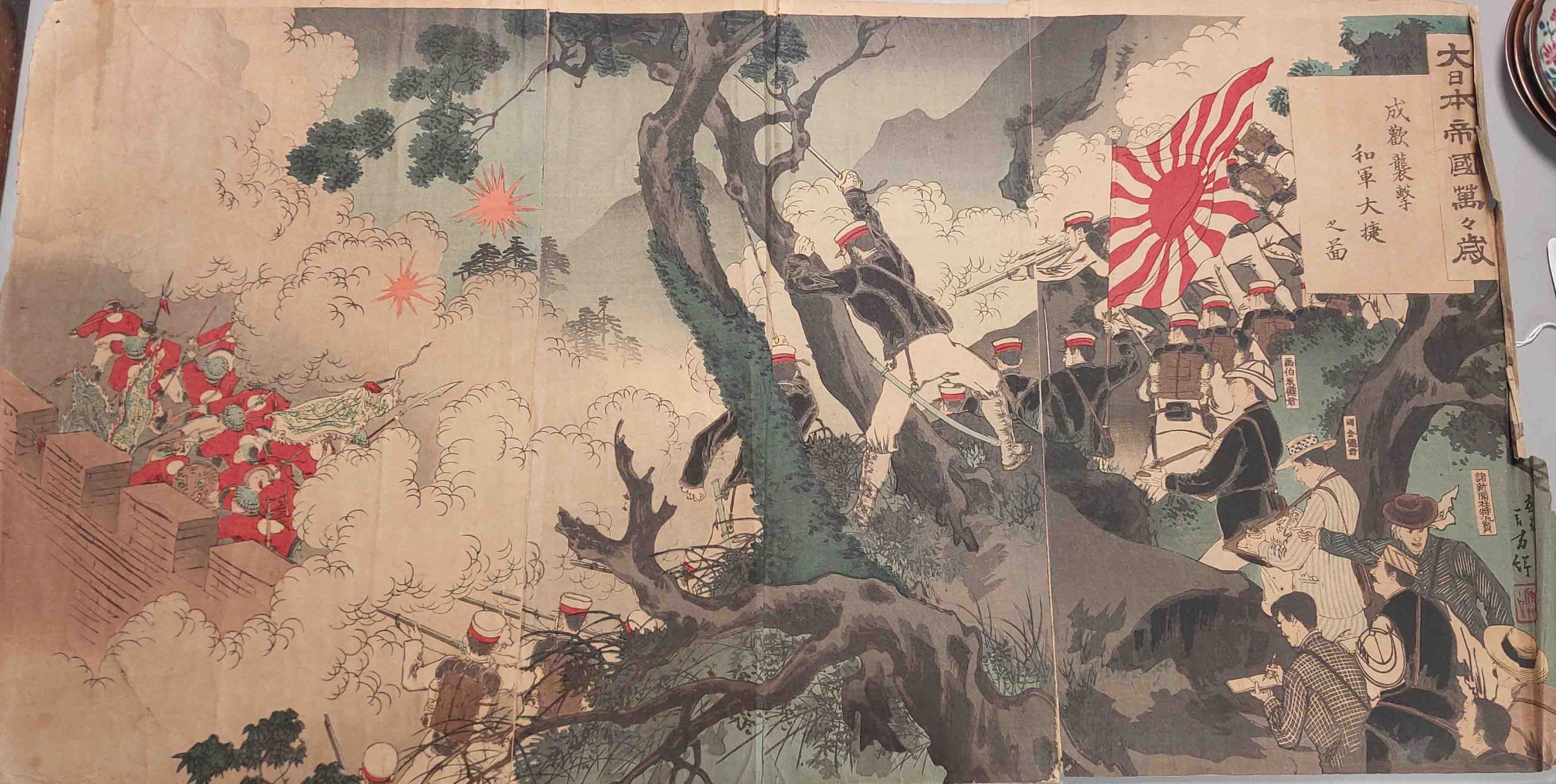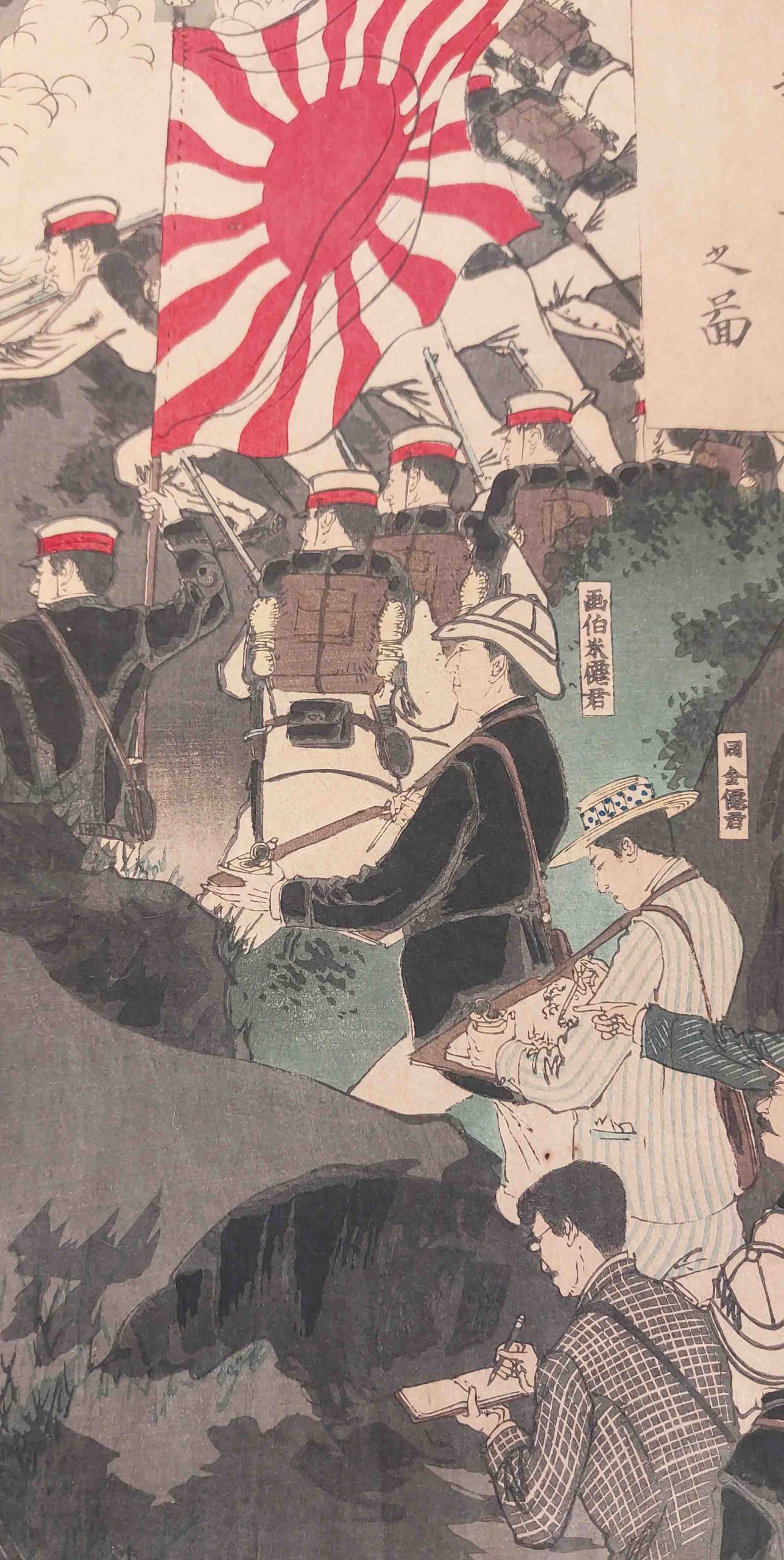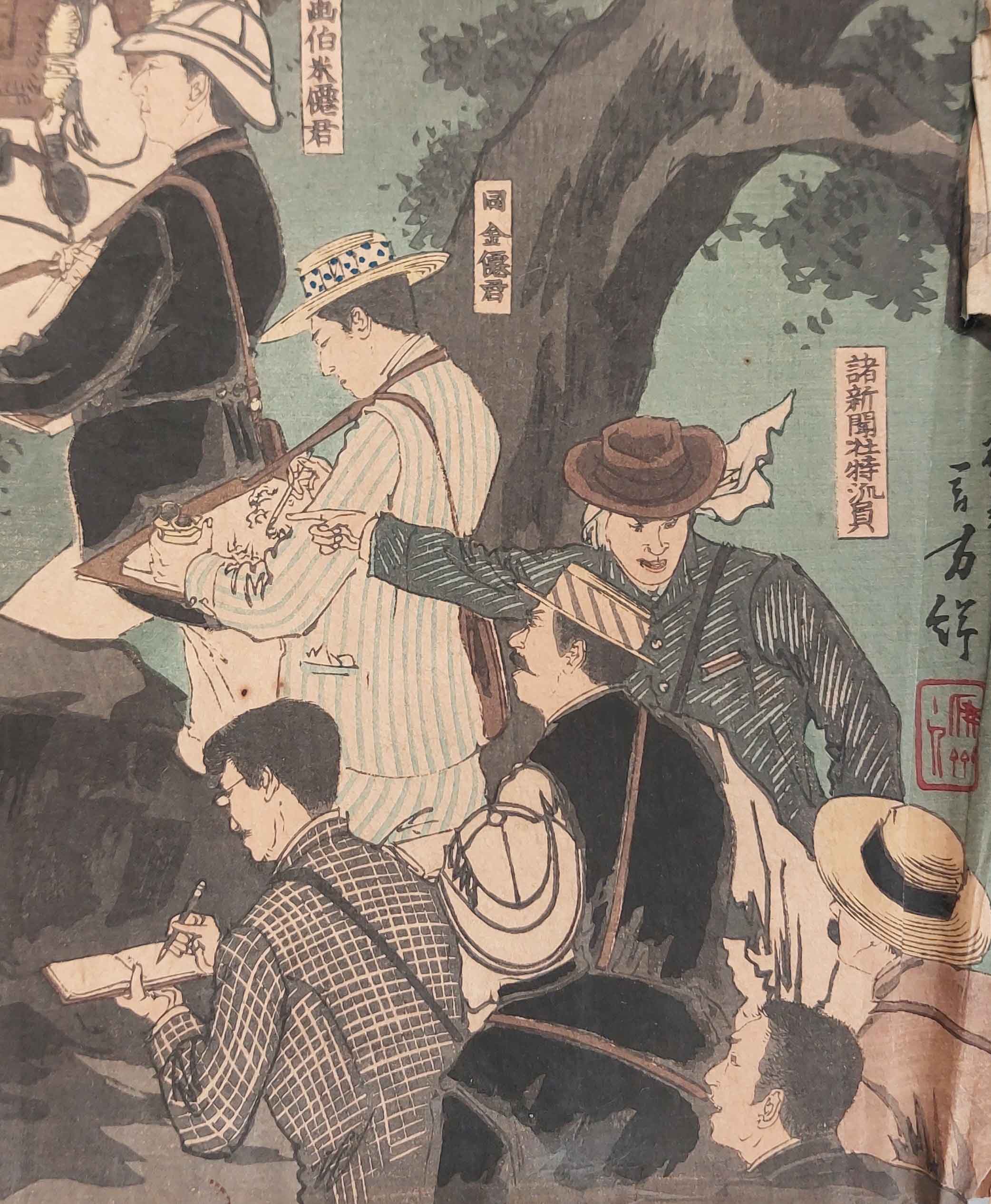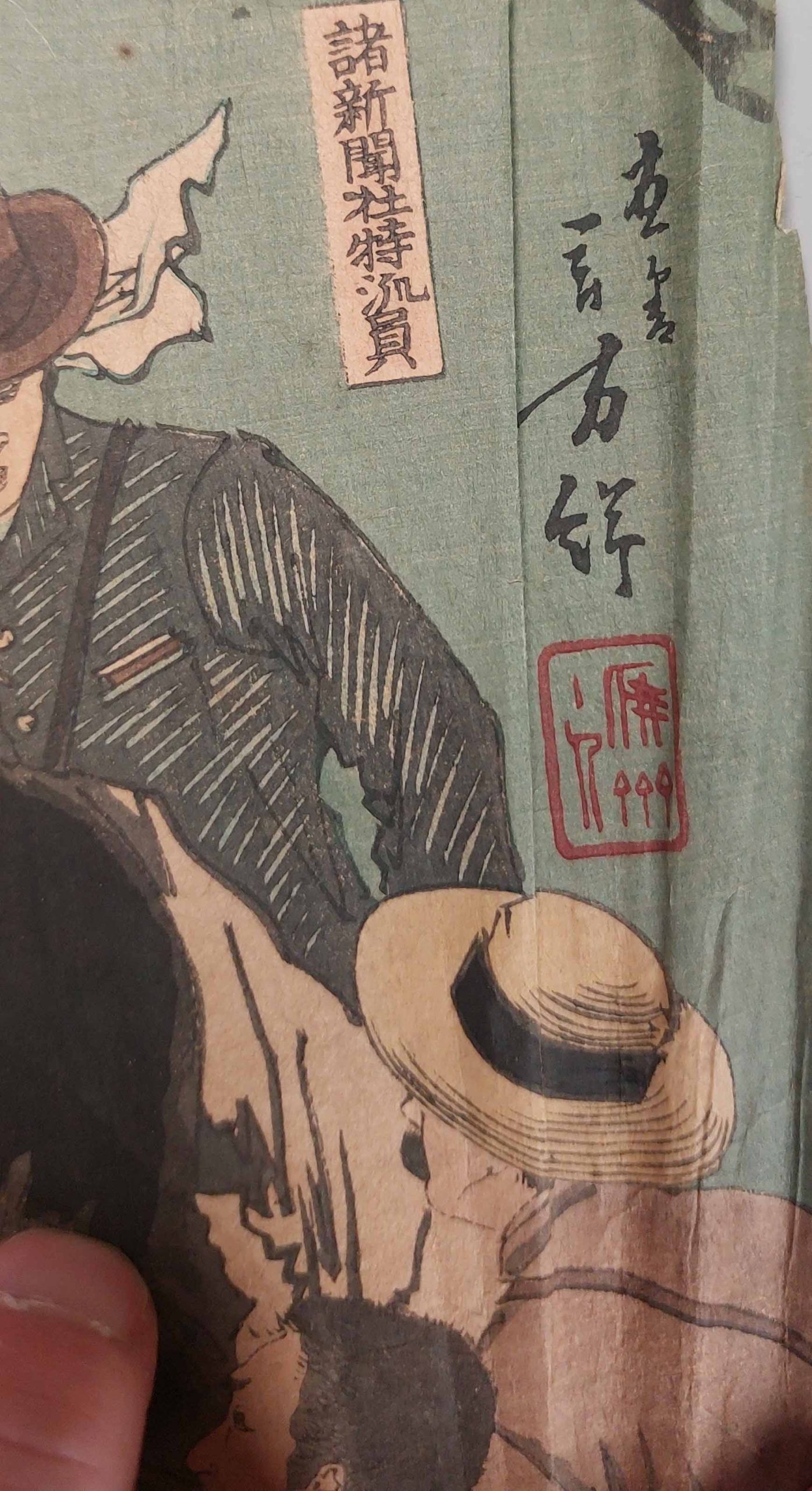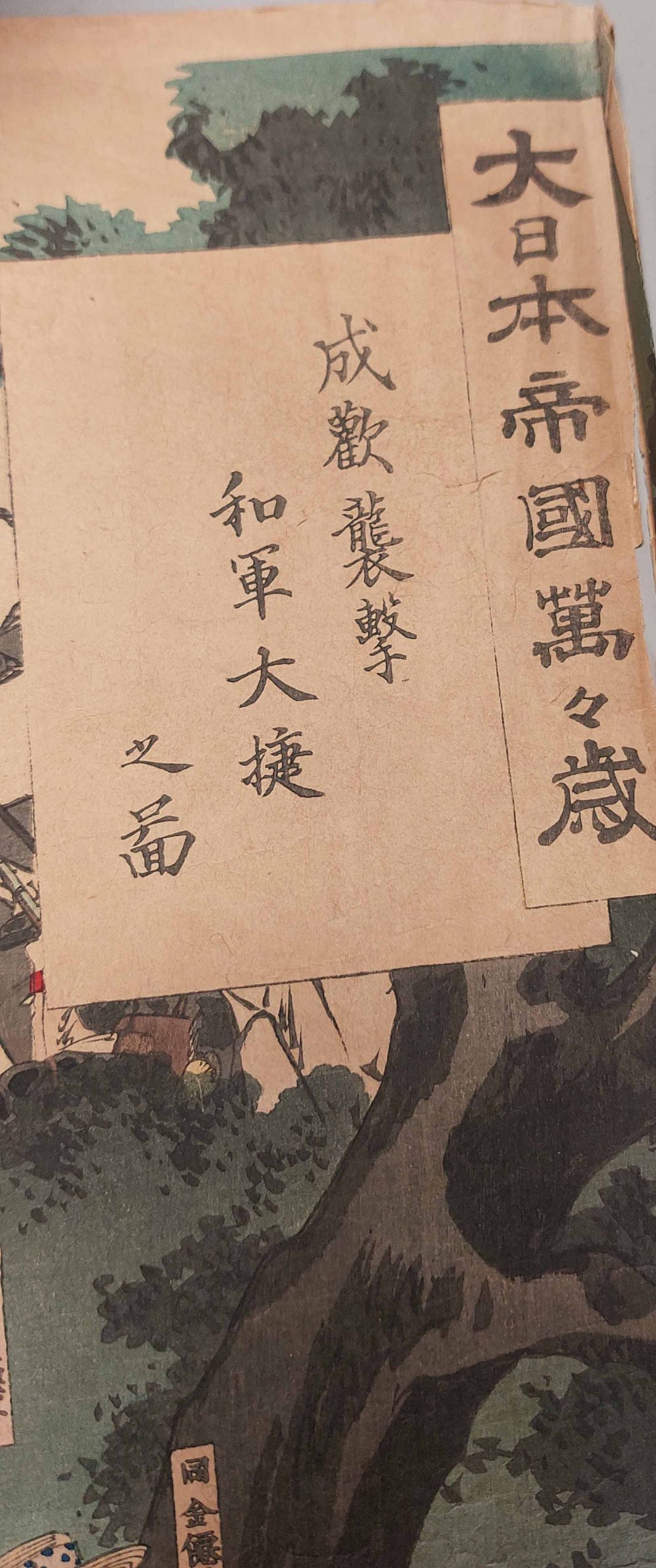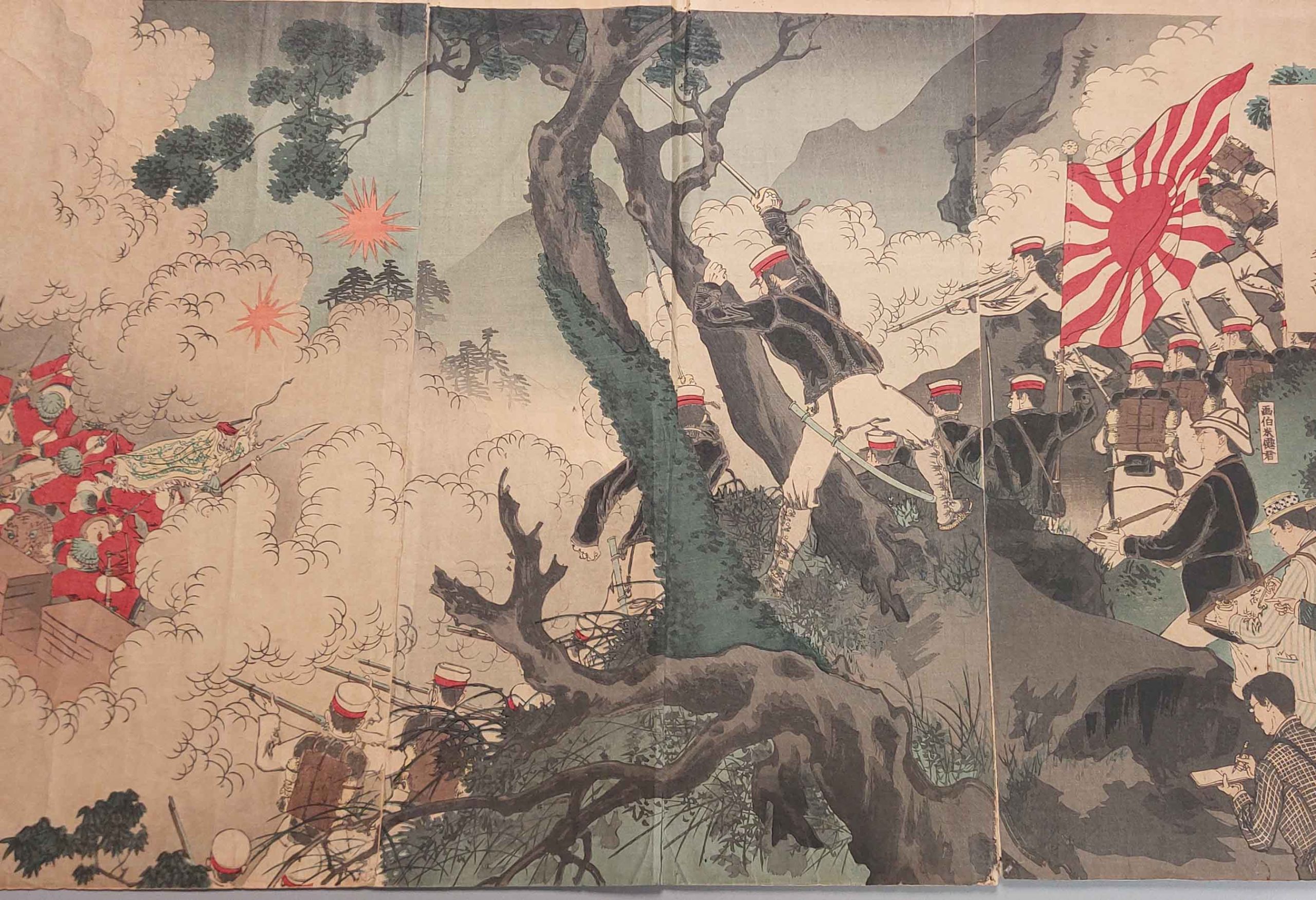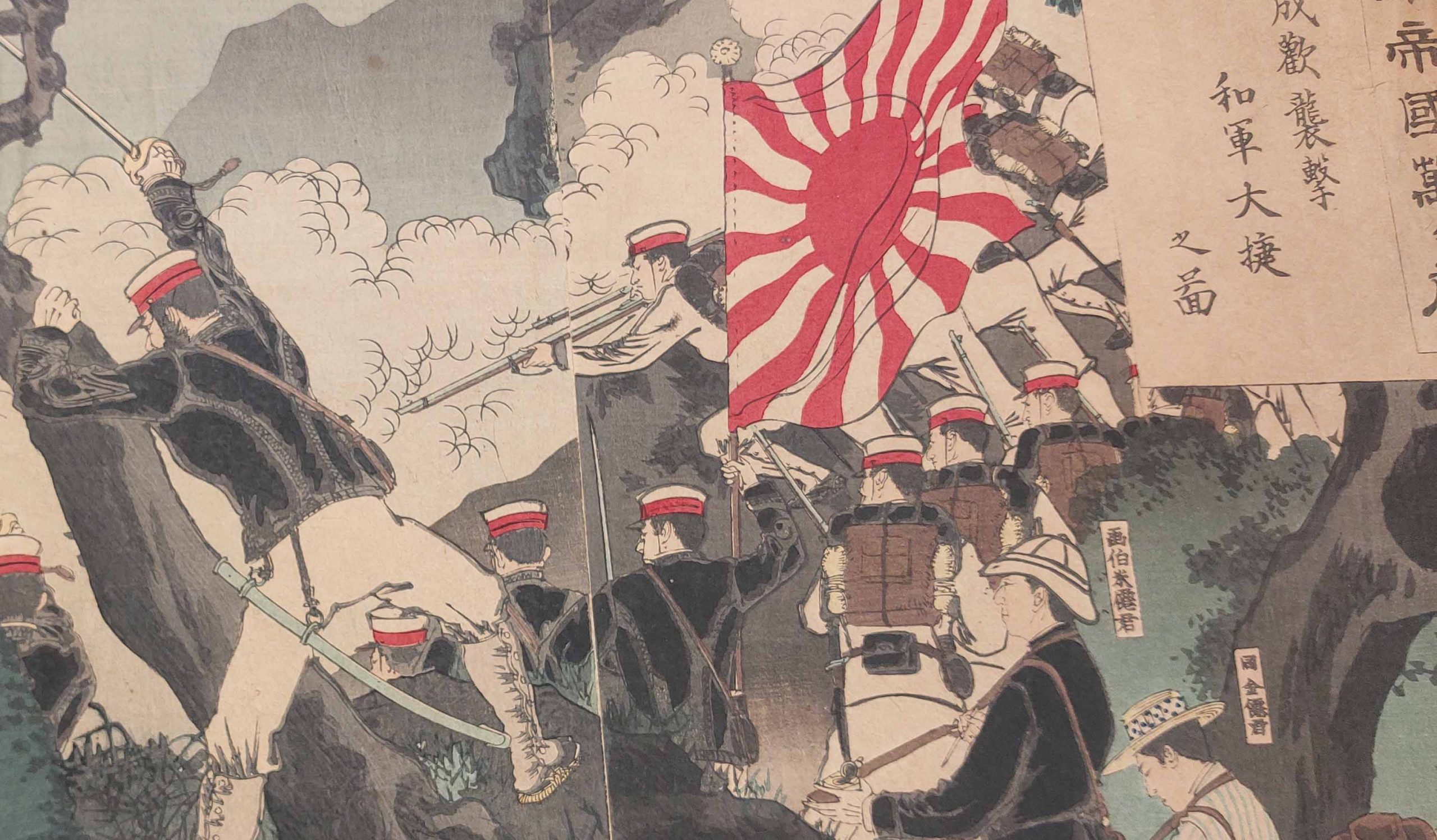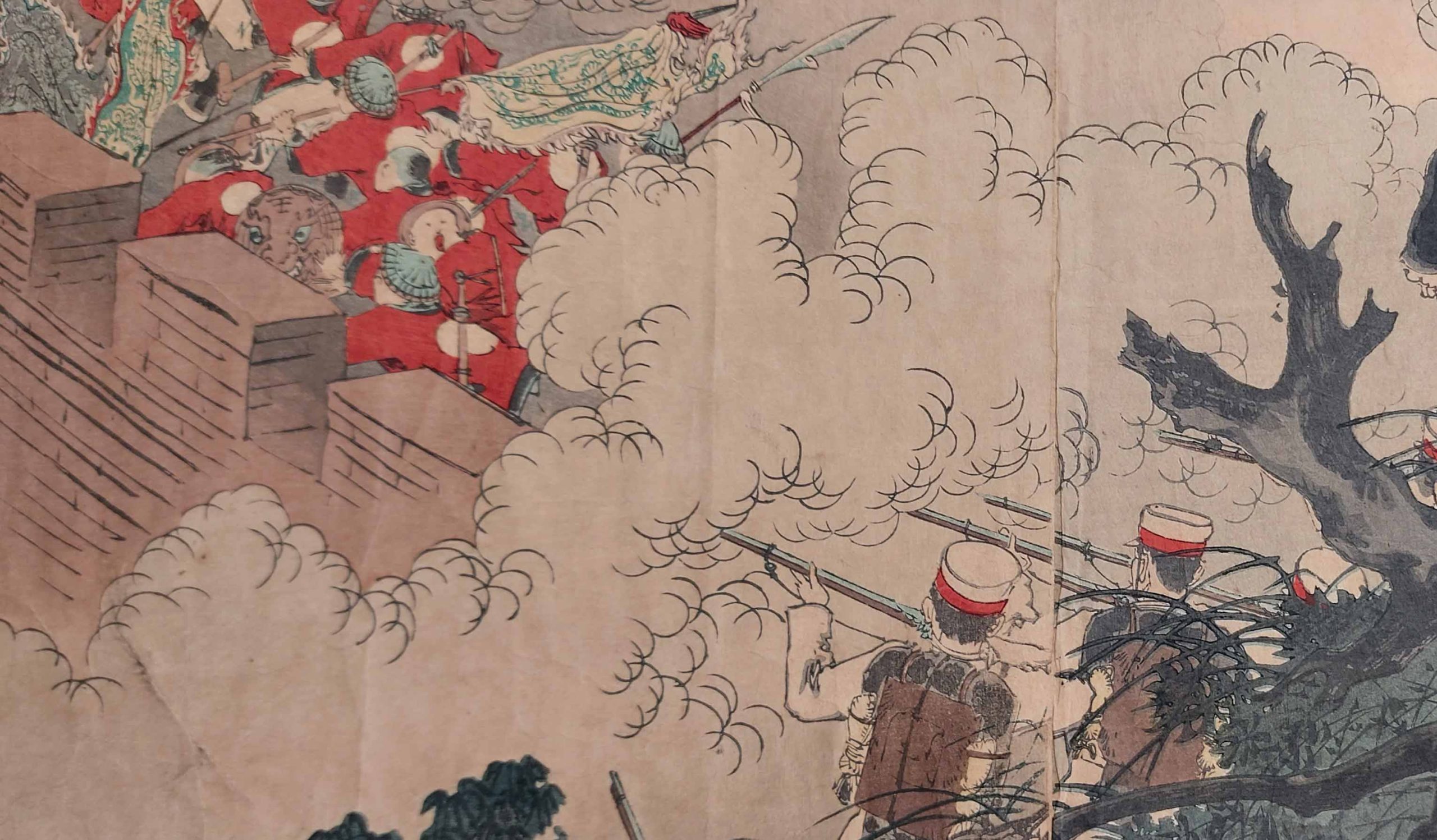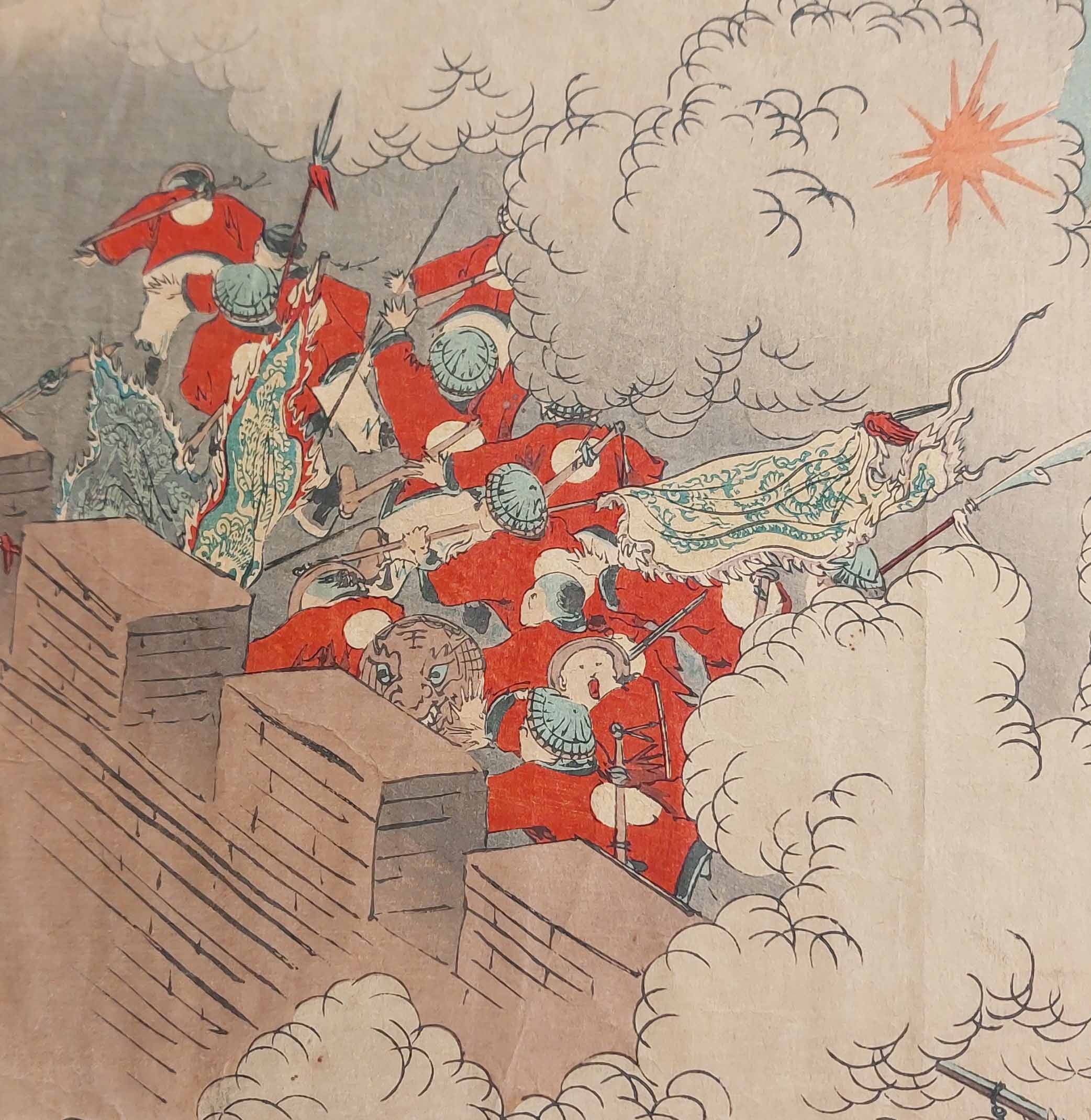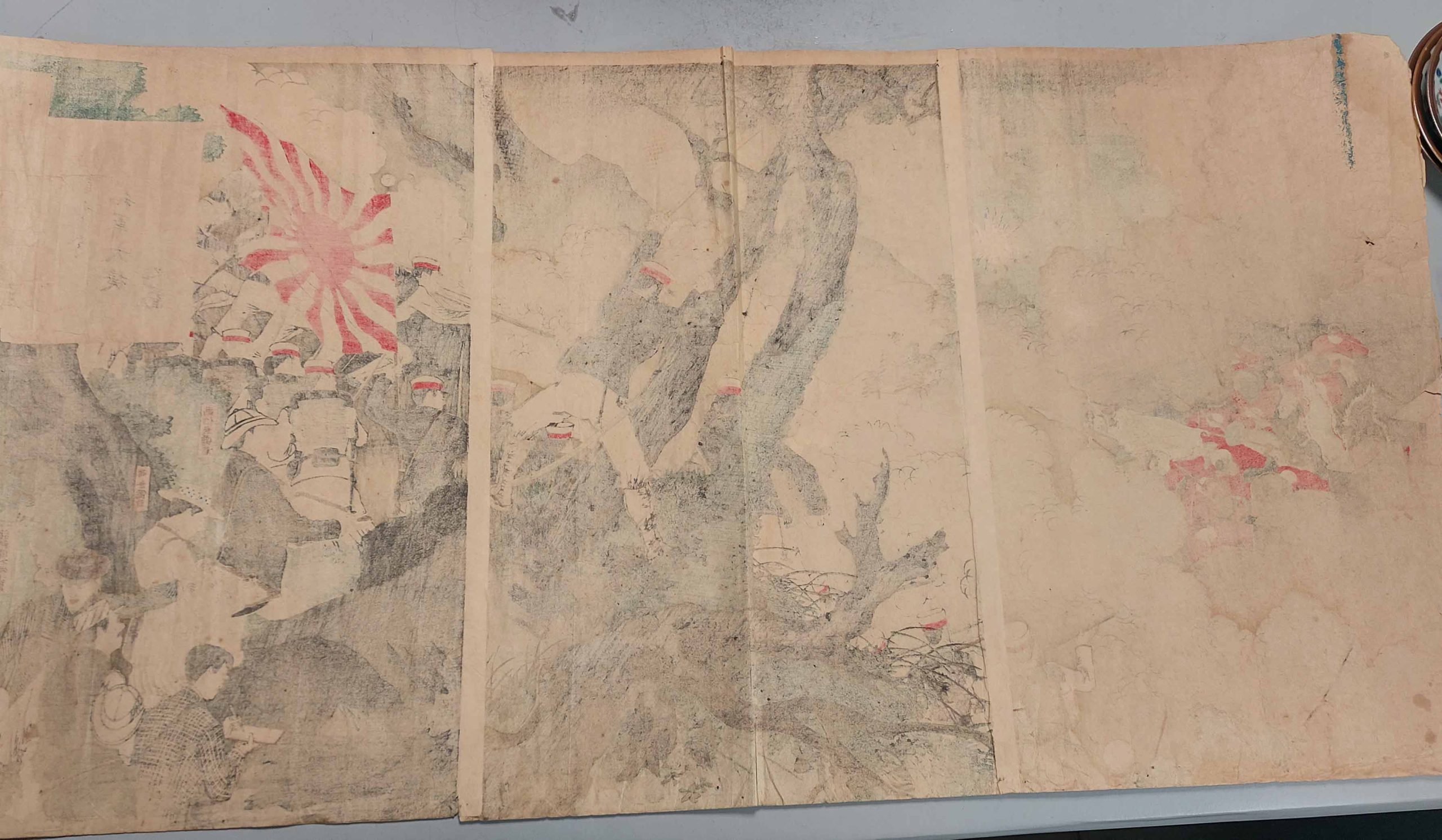Antique 19th c Woodblock Print by Mizuno Toshikata – Sino Japan Battle_of_Songhwan
有货
Condition Report: Used condition, damages to the margins and rims. Folding and ripping. Size: 70x37cm
A very strong woodblock print
Long live the Great Japanese Empire! Our army’s victorious attack on Seonghwan, Mizuno Toshikata 1866–1908
or
Hurrah and Hurrah Again for the Great Empire of Japan! Great Victory for the Japanese Army in the Assault on Seonghwan
A unique print thats in many musea around the world
About This Print
Battle of Songhwan Observed by Japanese War Correspondents
Source: Impressions of the Front: Woodcuts of the Sino-Japanese War, Shunpei Okamoto, Philadelphia Museum of Art, 1983, p. 20.
Eight war correspondents are shown observing the Japanese assault on Chinese troops at Songhwan1 成歓作戦 Korea on July 29, 1894. The foremost reporter in this scene, the white-capped Kubota Beisen (1852-1906), was also a painter, whose observations are recorded in a series of pictorial reports on the Sino-Japanese War. He wrote:
| The company taking the left wing arrived atop the heights northeast of Songhwan at 5:20 AM and, having dug in, started shelling the enemy camp, which was well within range, causing a great deal of damage and a great number of casualties. The infantry also advanced.
With a full strike force our men captured five enemy camps by 7:30 AM and the battered Chinese fled, leaving countless quantities of ammunition and supplies, including eight field guns. In these two hours of fierce battle, China suffered five hundred casualties, and Japan, ninety, including two officers. |
1 The Battle of Songhwan (a fort northeast of Asan) is sometimes referred to as the Battle of Asan. Asan, a stronghold south of Seoul, was occupied by the Japanese the next day without a fight.
Source: The Sino-Japanese War, Nathan Chaikin, self-published, 1983, p. 67.
It was the first battle fought by Japan in a foreign war in three hundred years, and it was the first experiment of a new army organized entirely on the European system. Although the Japanese were confident of success, it must have been satisfying to them to find their expectations so fully realized. The Asan campaign was a small affair, but its prompt execution showed that the generals knew how to command, and that the army organization worked smoothly, even in a country without good roads.
Kubota Beisen – Artist and War Correspondent
Source: Japan at the Dawn of the Modern Age – Woodblock Prints from the Meiji Era, Louise E. Virgin, Donald Keene, et. al., MFA Publications, 2001, p. 68.

A unique and important source of inspiration for the Sino-Japanese War print artists was the journalistic reports written and illustrated by the Kyoto painter Kubota Beisen (1852-1906), pictured on the left. Accompanied by his two sons, Beisai and Kinsen, Beisen actually followed the troops and recorded their battles in words and sketches. And Beisen himself was depicted almost as a war hero in a small number of triptych designs. One such print by Toshikata (dated August 1894) shows Beisen and his younger son, Kinsen, among the eight foreign correspondents who observed the assault on Songhwan on July 29, 1894, three days before Japan’s official declaration of war. Beisen, wearing a white pith helmet and a black jacket, and Kinsen, wearing a flat-brimmed straw hat and a white suit with blue stripes, are both sketching battle scenes with brush and ink on portable drawing desks. One can catch a glimpse of Kinsen’s drawing of soldiers in the print.
Source: In Battle’s Light: Woodblock Prints of Japan’s Early Modern Wars, Elizabeth de Sabato Swinton, Worcester Art Museum, 1991, p. 72.
Followed with interest in newspapers and weekly magazines throughout Japan and the world, the Sino-Japanese War introduced a new occupation to the Japanese – war correspondent. This print documents the new phenomenon and identifies those who accompanied the army in the assault on Songhwan on July 29, 1894, before the formal declaration of war. The figures on the right are simply classified as “newspaper correspondents” (sho-shimbusnsha tokuhain), but those on the left are identified by name – “artist Kinsen” (gahaku Kinsen-kun) and “artist Beisen” (gahaku Beisen-kun). Kubota Beisen (1852-1906), wearing the white pith helmet, was a well-known Kyoto painter. The most important Japanese reporter at the front, he sent eyewitness reports and illustrations that are a primary source of information on the battles. His son Kinsen (1875-1954) was a correspondent during both the Sino-Japanese and Russo-Japanese wars.
https://www.artic.edu/artworks/223519/long-live-the-great-japanese-empire-a-great-victory-for-our-troops-in-the-assault-on-songhwan-dai-nihon-teikoku-banbanzai-seikan-shugeki-waga-gun-taisho-no-zu
Additional Information
| 重量 | 4 公斤 |
|---|---|
| Type | |
| Region of Origin | |
| Primary Material | |
| Century | |
| Decoration Type / Colour | |
| Material | |
| Condition Report | Used condition, damages to the margins and rims. Folding and ripping. Size: 70x37cm |
